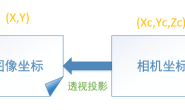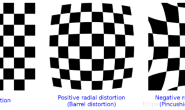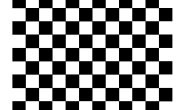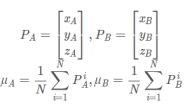相机标定(二)——图像坐标与世界坐标转换
一、坐标关系
相机中有四个坐标系,分别为world,camera,image,pixel
- world为世界坐标系,可以任意指定xw轴和yw轴,为上图P点所在坐标系。
- camera为相机坐标系,原点位于小孔,z轴与光轴重合,xw轴和yw轴平行投影面,为上图坐标系XcYcZc。
- image为图像坐标系,原点位于光轴和投影面的交点,xw轴和yw轴平行投影面,为上图坐标系XYZ。
- pixel为像素坐标系,从小孔向投影面方向看,投影面的左上角为原点,uv轴和投影面两边重合,该坐标系与图像坐标系处在同一平面,但原点不同。
二、坐标变换
下式为像素坐标pixel与世界坐标world的变换公式,右侧第一个矩阵为相机内参数矩阵,第二个矩阵为相机外参数矩阵。
2.1 变换流程
该方程右侧隐含了一次齐次坐标到非齐次坐标的转换
顺序变换
- 从pixel到camera,使用内参变换
- 从camera到world,使用外参变换
注意:两个变换之间的矩阵大小不同,需要分开计算,从pixel到camera获得的相机坐标为非齐次,需转换为齐次坐标再进行下一步变换。而在进行从camera到world时,需将外参矩阵转换为齐次再进行计算。(齐次坐标的分析)
直接变换
注意:直接变换是直接根据变换公式获得,实际上包含pixel到camera和camera到world,实际上和顺序变换一样,通过顺序变换可以更清晰了解变换过程。
2.2 参数计算
- 内参:通过张正友标定获得
- 外参:通过PNP估计获得
- 深度s:深度s为目标点在相机坐标系Z方向的值
2.3 外参计算
- solvePnP函数
Perspective-n-Point是通过n组给定点的世界坐标与像素坐标估计相机位置的方法。OpenCV内部提供的函数为solvePnP(),函数介绍如下:
bool solvePnP(InputArray objectPoints,
InputArray imagePoints,
InputArray cameraMatrix,
InputArray distCoeffs,
OutputArray rvec,
OutputArray tvec,
bool useExtrinsicGuess=false,
int flags=ITERATIVE )
- objectPoints,输入世界坐标系中点的坐标;
- imagePoints,输入对应图像坐标系中点的坐标;
- cameraMatrix, 相机内参数矩阵;
- distCoeffs, 畸变系数;
- rvec, 旋转向量,需输入一个非空Mat,需要通过cv::Rodrigues转换为旋转矩阵;
- tvec, 平移向量,需输入一个非空Mat;
- useExtrinsicGuess, 默认为false,如果设置为true则输出输入的旋转矩阵和平移矩阵;
- flags,选择采用的算法;
CV_ITERATIVE Iterative method is based on Levenberg-Marquardt optimization. In this case the function finds such a pose that minimizes reprojection error, that is the sum of squared distances between the observed projections imagePoints and the projected (using projectPoints() ) objectPoints .
CV_P3P Method is based on the paper of X.S. Gao, X.-R. Hou, J. Tang, H.-F. Chang “Complete Solution Classification for the Perspective-Three-Point Problem”. In this case the function requires exactly four object and image points.
CV_EPNP Method has been introduced by F.Moreno-Noguer, V.Lepetit and P.Fua in the paper “EPnP: Efficient Perspective-n-Point Camera Pose Estimation”.
注意:solvePnP()的参数rvec和tvec应该都是double类型的
- 程序实现
//输入参数
Mat cameraMatrix = Mat(3, 3, CV_32FC1, Scalar::all(0)); /* 摄像机内参数矩阵 */
Mat distCoeffs = Mat(1, 5, CV_32FC1, Scalar::all(0)); /* 摄像机的5个畸变系数:k1,k2,p1,p2,k3 */
double zConst = 0;//实际坐标系的距离,若工作平面与相机距离固定可设置为0
//计算参数
double s;
Mat rotationMatrix = Mat (3, 3, DataType<double>::type);
Mat tvec = Mat (3, 1, DataType<double>::type);
void calcParameters(vector<cv::Point2f> imagePoints, vector<cv::Point3f> objectPoints)
{
//计算旋转和平移
Mat rvec(3, 1, cv::DataType<double>::type);
cv::solvePnP(objectPoints, imagePoints, cameraMatrix, distCoeffs, rvec, tvec);
cv::Rodrigues(rvec, rotationMatrix);
}
2.4 深度计算
理想情况下,相机与目标平面平行(只有绕Z轴的旋转),但实际上相机与目标平面不会完全平行,存在绕X和Y轴的旋转,此时深度s并不是固定值t3,计算深度值为:
若使用固定值进行变换会导致较大误差。解决方案如下:
- 计算多个点的深度值,拟合一个最优值
- 通过外参计算不同位置的深度(此处采用该方案)
注意:此处环境为固定单目与固定工作平面,不同情况下获得深度方法不同。
像素坐标pixel与世界坐标world转换公式可简化为
M为相机内参数矩阵,R为旋转矩阵,t为平移矩阵,zconst为目标点在世界坐标Z方向的值,此处为0。
变换可得
当相机内外参已知可计算获得s
三、程序实现
3.1 Matlab
clc;
clear;
% 内参
syms fx cx fy cy;
M = [fx,0,cx;
0,fy,cy;
0,0,1];
% 外参
%旋转矩阵
syms r11 r12 r13 r21 r22 r23 r31 r32 r33;
R = [r11,r12,r13;
r21,r22,r23;
r31,r32,r33];
%平移矩阵
syms t1 t2 t3;
t = [t1;
t2;
t3];
%外参矩阵
T = [R,t;
0,0,0,1];
% 图像坐标
syms u v;
imagePoint = [u;v;1];
% 计算深度
syms zConst;
rightMatrix = inv(R)*inv(M)*imagePoint;
leftMatrix = inv(R)*t;
s = (zConst + leftMatrix(3))/rightMatrix(3);
% 转换世界坐标方式一
worldPoint1 = inv(R) * (s*inv(M) * imagePoint - t);
simplify(worldPoint1)
% 转换世界坐标方式二
cameraPoint = inv(M)* imagePoint * s;% image->camrea
worldPoint2 = inv(T)* [cameraPoint;1];% camrea->world
worldPoint2 = [worldPoint2(1);worldPoint2(2);worldPoint2(3)];
simplify(worldPoint2)
3.2 C++
该程序参考《视觉SLAM十四讲》第九讲实践章:设计前端代码部分进行修改获得,去掉了李群库Sopuhus依赖,因该库在windows上调用较为麻烦,若在Linux建议采用Sopuhus。
- camera.h
#ifndef CAMERA_H
#define CAMERA_H
#include <Eigen/Core>
#include <Eigen/Geometry>
using Eigen::Vector4d;
using Eigen::Vector2d;
using Eigen::Vector3d;
using Eigen::Quaterniond;
using Eigen::Matrix;
class Camera
{
public:
Camera();
// coordinate transform: world, camera, pixel
Vector3d world2camera( const Vector3d& p_w);
Vector3d camera2world( const Vector3d& p_c);
Vector2d camera2pixel( const Vector3d& p_c);
Vector3d pixel2camera( const Vector2d& p_p);
Vector3d pixel2world ( const Vector2d& p_p);
Vector2d world2pixel ( const Vector3d& p_w);
// set params
void setInternalParams(double fx, double cx, double fy, double cy);
void setExternalParams(Quaterniond Q, Vector3d t);
void setExternalParams(Matrix<double, 3, 3> R, Vector3d t);
// cal depth
double calDepth(const Vector2d& p_p);
private:
// 内参
double fx_, fy_, cx_, cy_, depth_scale_;
Matrix<double, 3, 3> inMatrix_;
// 外参
Quaterniond Q_;
Matrix<double, 3, 3> R_;
Vector3d t_;
Matrix<double, 4, 4> exMatrix_;
};
#endif // CAMERA_H
- camera.cpp
#include "camera.h"
Camera::Camera(){}
Vector3d Camera::world2camera ( const Vector3d& p_w)
{
Vector4d p_w_q{ p_w(0,0),p_w(1,0),p_w(2,0),1};
Vector4d p_c_q = exMatrix_ * p_w_q;
return Vector3d{p_c_q(0,0),p_c_q(1,0),p_c_q(2,0)};
}
Vector3d Camera::camera2world ( const Vector3d& p_c)
{
Vector4d p_c_q{ p_c(0,0),p_c(1,0),p_c(2,0),1 };
Vector4d p_w_q = exMatrix_.inverse() * p_c_q;
return Vector3d{ p_w_q(0,0),p_w_q(1,0),p_w_q(2,0) };
}
Vector2d Camera::camera2pixel ( const Vector3d& p_c )
{
return Vector2d (
fx_ * p_c ( 0,0 ) / p_c ( 2,0 ) + cx_,
fy_ * p_c ( 1,0 ) / p_c ( 2,0 ) + cy_
);
}
Vector3d Camera::pixel2camera ( const Vector2d& p_p)
{
double depth = calDepth(p_p);
return Vector3d (
( p_p ( 0,0 )-cx_ ) *depth/fx_,
( p_p ( 1,0 )-cy_ ) *depth/fy_,
depth
);
}
Vector2d Camera::world2pixel ( const Vector3d& p_w)
{
return camera2pixel ( world2camera(p_w) );
}
Vector3d Camera::pixel2world ( const Vector2d& p_p)
{
return camera2world ( pixel2camera ( p_p ));
}
double Camera::calDepth(const Vector2d& p_p)
{
Vector3d p_p_q{ p_p(0,0),p_p(1,0),1 };
Vector3d rightMatrix = R_.inverse() * inMatrix_.inverse() * p_p_q;
Vector3d leftMatrix = R_.inverse() * t_;
return leftMatrix(2,0)/rightMatrix(2,0);
}
void Camera::setInternalParams(double fx, double cx, double fy, double cy)
{
fx_ = fx;
cx_ = cx;
fy_ = fy;
cy_ = cy;
inMatrix_ << fx, 0, cx,
0, fy, cy,
0, 0, 1;
}
void Camera::setExternalParams(Quaterniond Q, Vector3d t)
{
Q_ = Q;
R_ = Q.normalized().toRotationMatrix();
setExternalParams(R_,t);
}
void Camera::setExternalParams(Matrix<double, 3, 3> R, Vector3d t)
{
t_ = t;
R_ = R;
exMatrix_ << R_(0, 0), R_(0, 1), R_(0, 2), t(0,0),
R_(1, 0), R_(1, 1), R_(1, 2), t(1,0),
R_(2, 0), R_(2, 1), R_(2, 2), t(2,0),
0, 0, 0, 1;
}
参考
image coordinate to world coordinate opencv
Computing x,y coordinate (3D) from image point
《视觉SLAM十四讲》—相机与图像+实践章:设计前端













